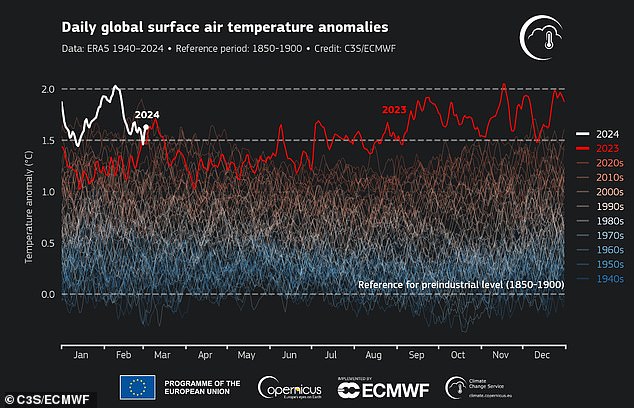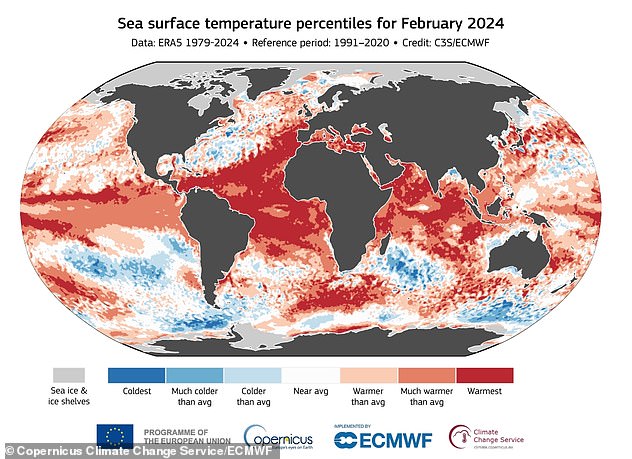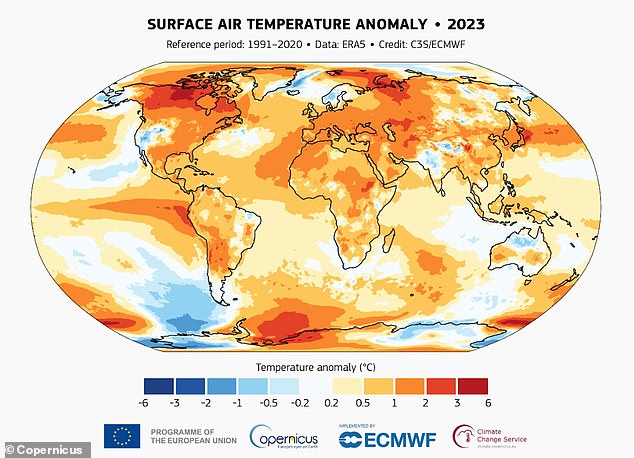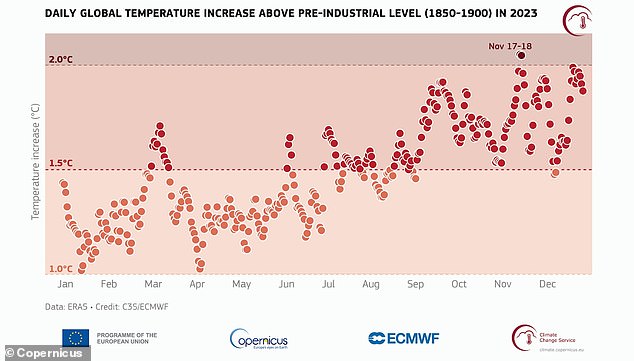Last month was officially the warmest February on RECORD, with global temperatures 0.81°C above average – and experts say climate change is to blame
With daffodils blooming early, snow melting at ski resorts and even sunbathing in the Northern Hemisphere, you might have guessed it.
But it’s now official: last month was the warmest February on record, according to the EU’s climate change programme.
The global average temperature for the month was 56.3 F (13.54 C), which is 0.21 F (0.12 C) above the temperature of the previous warmest February in 2016.
Worryingly, this is also 0.81°C warmer than the 1991-2020 global average for February – and experts blame greenhouse gas emissions.
EU scientists have already revealed that last year was the hottest year on record, while July 2023 was the hottest month on record.
February 2024 was the warmest February on record globally, with an average surface air temperature of 56.3°F (13.54°C)

Men bathe in the 14°C sea during a warm weekend, with the Sanguinaires Islands in the background, on the French Mediterranean island of Corsica, in Porticcio, February 18, 2024
“February joins the long line of records in recent months,” said Carlo Buontempo, director of the Copernicus Climate Change Service (C3S).
‘As remarkable as this may seem, it is not really surprising, as the continued warming of the climate system will inevitably lead to new temperature extremes.
‘The climate responds to the actual concentrations of greenhouse gases in the atmosphere, so unless we manage to stabilize these, we will inevitably experience new global temperature records and their consequences.’
C3S, managed by the European Commission, is looking into it temperature measurements based on a variety of platforms and instruments, from weather stations to weather balloons and satellites.
The department’s measurements refer to the average air temperature for the entire planet over the entire year – so lower than a single typical ‘hot’ temperature measurement.
According to C3S, February 2024 is the ninth month in a row that has been the warmest month on record for that month.
It was 1.77°C warmer than an estimate of the February average for the period 1850-1900, the ‘pre-industrial’ reference period.

The graph shows the daily global mean surface air temperature (°C) deviations from the estimated values for 1850-1900 for 2024 (in white) and 2023 (red)

Daffodils bloom in St James’s Park with the London Eye in the background, London, February 23, 2024

Pictured: A snowless ski slope at the Artouste ski area in Laruns, in the Pyrénées Atlantiques, south-west France, February 19, 2024

A ski resort in Orlicke Zahori in the Orlicke Mountains, Czech Republic, suffers from a lack of snow, February 10, 2024
The daily global average temperature was “exceptionally high” during the first half of the month, reaching 3.6 F (2 °C) above the 1850–1900 level on four consecutive days (February 8 to 11).
This is worrying because it is a global goal to keep global average temperatures within 2°C and if possible 1.5°C as part of the Paris Agreement, a binding climate treaty signed in 2016.
Fortunately, the news does not mean that we have exceeded the limits of the Paris Agreement (as they refer to periods of at least twenty years in which this average temperature deviation is exceeded).
Looking at Europe separately from the rest of the world, temperatures last month were 5.94 F (3.3 C) above the 1991-2020 February average.
Many of the above-average temperatures were experienced in central and eastern Europe, but they were above-average in northern Siberia, central and northwestern North America, most of South America, throughout Africa and in Western Australia.
CS3’s main metric for measuring how warm it is is the temperature of the air, but it also tracks the temperatures of the world’s oceans.
It looks at sea surface temperature – how hot the water is close to the ocean surface.
CS3 said the average global sea surface temperature for February 2024 was 37.91°F (21.06°C), the highest for any month in the dataset and above the previous record set in August 2023 (69.76°F/20.98 °C).

People sit on the banks of the Seine to enjoy the warm weather in front of the Pont des Arts in Paris on February 15, 2024

A jogger runs along the downtown Riverwalk during an unusually warm winter day on February 27, 2024 in Chicago, Illinois

Skiers use a lift on a partially snow-covered ski slope at the Alpine resort of Les Mosses, in Ormont-Dessous, Switzerland, February 6, 2024. Mild weather in the Swiss Alps in recent days disrupted activity at alpine ski resorts

In the photo the sea surface temperature for February 2024. This is a separate measure of how warm the world is
In the future, it is possible that an upcoming month in 2024 could replace July 2023 as the warmest month on record.
The global average temperature for July 2023 was 62.51 °F (16.95 °C), the highest since records began in 1940 and well above the previous record of 61.93 °F (16.63 °C) from July 2019.
Meanwhile, overall, 2023 set the record for the hottest year on record, largely due to ‘unprecedented’ global temperatures from June onwards, fueled mainly by greenhouse gases.
Atmospheric concentrations of carbon dioxide and methane (the two main greenhouse gases) continued to rise, reaching record levels in 2023.

2023 is confirmed as the warmest calendar year in global temperature records dating back to 1850. The global average air temperature was 58.96 °F (14.98 °C), about 0.3 °F (0.17 °C) higher than the result in 2016

In 2023, two days in November (17 and 18) were more than 2°C warmer than the ‘pre-industrial’ average for the first time
Furthermore, every month from June to December in 2023 was warmer than the corresponding month in any year.
Several months of 2023 were the hottest on record for that specific month, such as September, November and December, as well as July (not only the hottest July on record, but also the hottest month on record).
“2023 was an exceptional year in which climate records fell like dominoes,” said Samantha Burgess, deputy director of C3S.
“Temperatures in 2023 are likely to be higher than any period in the past 100,000 years.”
